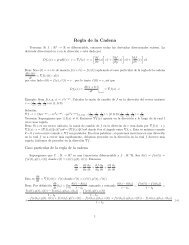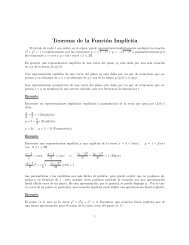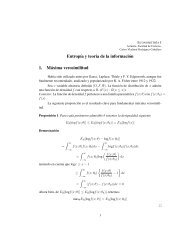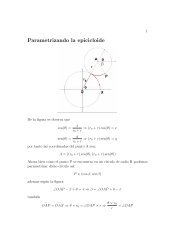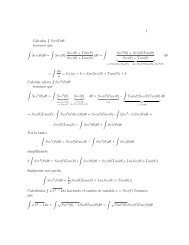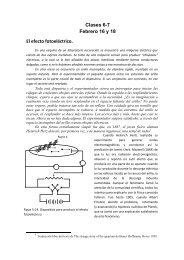"Surely You're Joking, Mr. Feynman!" - unam.
"Surely You're Joking, Mr. Feynman!" - unam.
"Surely You're Joking, Mr. Feynman!" - unam.
Create successful ePaper yourself
Turn your PDF publications into a flip-book with our unique Google optimized e-Paper software.
around faster than the wobbling.<br />
I had nothing to do, so I start to figure out the motion of the rotating plate. I<br />
discover that when the angle is very slight, the medallion rotates twice as fast as the<br />
wobble rate two to one. It came out of a complicated equation! Then I thought, "Is<br />
there some way I can see in a more fundamental way, by looking at the forces or the<br />
dynamics, why it's two to one?"<br />
I don't remember how I did it, but I ultimately worked out what the motion of the<br />
mass particles is, and how all the accelerations balance to make it come out two to one.<br />
I still remember going to Hans Bethe and saying, "Hey, Hans! I noticed<br />
something interesting. Here the plate goes around so, and the reason it's two to one is. . ."<br />
and I showed him the accelerations.<br />
He says, "<strong>Feynman</strong>, that's pretty interesting, but what's the importance of it? Why<br />
are you doing it?"<br />
"Hah!" I say. "There's no importance whatsoever. I'm just doing it for the fun of<br />
it." His reaction didn't discourage me; I had made up my mind I was going to enjoy<br />
physics and do whatever I liked.<br />
I went on to work out equations of wobbles. Then I thought about how electron<br />
orbits start to move in relativity. Then there's the Dirac Equation in electrodynamics. And<br />
then quantum electrodynamics. And before I knew it (it was a very short time) I was<br />
"playing" working, really with the same old problem that I loved so much, that I had<br />
stopped working on when I went to Los Alamos: my thesistype problems; all those old<br />
fashioned, wonderful things.<br />
It was effortless. It was easy to play with these things. It was like uncorking a<br />
bottle: Everything flowed out effortlessly. I almost tried to resist it! There was no<br />
importance to what I was doing, but ultimately there was. The diagrams and the whole<br />
business that I got the Nobel Prize for came from that piddling around with the wobbling<br />
plate.<br />
Any Questions?<br />
When I was at Cornell I was asked to give a series of lectures once a week at an<br />
aeronautics laboratory in Buffalo. Cornell had made an arrangement with the laboratory<br />
which included evening lectures in physics to be given by somebody from the university.<br />
There was some guy already doing it, but there were complaints, so the physics<br />
department came to me. I was a young professor at the time and I couldn't say no very<br />
easily, so I agreed to do it.<br />
To get to Buffalo they had me go on a little airline which consisted of one<br />
airplane. It was called Robinson Airlines (it later became Mohawk Airlines) and I<br />
remember the first time I flew to Buffalo, <strong>Mr</strong>. Robinson was the pilot. He knocked the ice<br />
off the wings and we flew away.<br />
All in all, I didn't enjoy the idea of going to Buffalo every Thursday night. The<br />
university was paying me $35 in addition to my expenses. I was a Depression kid, and I<br />
figured I'd save the $35, which was a sizable amount of money in those days.<br />
Suddenly I got an idea: I realized that the purpose of the $35 was to make the trip<br />
to Buffalo more attractive, and the way to do that is to spend the money. So I decided to




